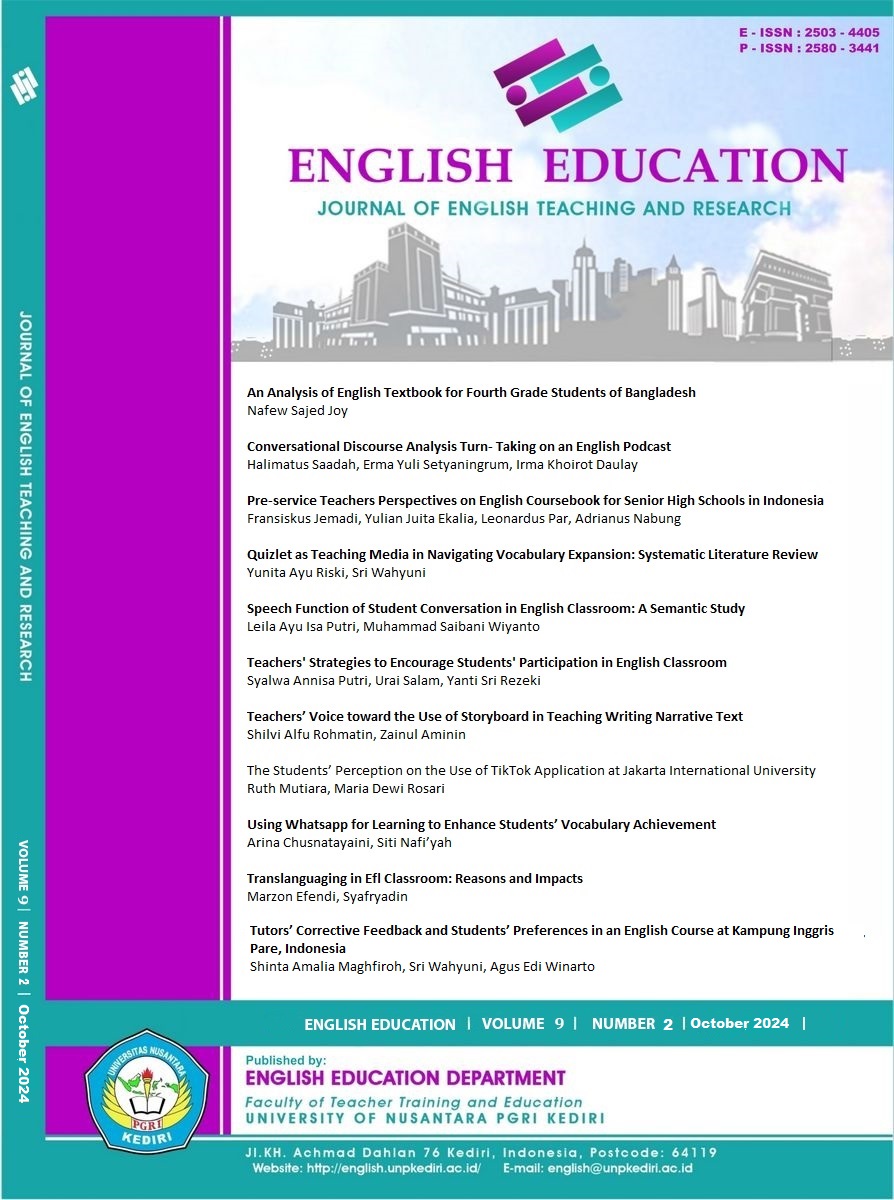An Analysis of English Textbook for Fourth Grade Students of Bangladesh
DOI:
https://doi.org/10.29407/jetar.v9i2.23036Keywords:
National Curriculum and Textbook Board (NCTB), English, Textbook Analysis, Textbook Analysis, National Curriculum and Textbook Board (NCTB)Abstract
This study critically examines the fourth-grade English textbook, English for Today, used in mainstream classrooms in Bangladesh. Despite 12 years of English instruction, many students in Bangladesh struggle with language proficiency, suggesting a gap between curriculum objectives and practical outcomes. The research investigates this gap by evaluating the textbook across four analytical stages. Initially, the study assesses the textbook’s aims, exercises, assessments, and learning process, identifying its intent to build language skills through engaging activities. The second step analyzes the textbook using various educational theories, such as social constructivism, Bloom’s taxonomy, the VARK model, and principles of pedagogy and educational psychology. These frameworks highlight the textbook’s attempt to foster active learning, critical thinking, and inclusivity. The third phase involves a critical evaluation of the textbook’s physical aspects, content quality, use of illustrations, and language structure. The research concludes with a content analysis, noting both strengths and weaknesses. The findings reveal that English for Today incorporates effective learning methods, such as hands-on activities and command-based instructions, aimed at enhancing student engagement. It demonstrates a strong alignment with educational theories, achieving a high readability score of 98.27. However, significant shortcomings are identified in the physical production of the textbook. Issues such as an unattractive cover, poor printing, and low-quality paper detract from the overall educational experience. Reflectively, the study underscores the importance of not just theoretical and content-based alignment in textbooks but also the material and visual aspects that affect students' motivation and engagement. While the textbook's pedagogical framework is sound, the findings suggest that improving its physical presentation could make it a more effective tool for language learning.
Downloads
References
Ali, M. M. & Walker, A. L. (2014). 'Bogged down’ ELT in Bangladesh: problems & policy. English Today, 30 (2), 33-38.
Anderson, R. (2007).Thematic Content Analysis: Descriptive Presentation of Qualitative Data.
Begum, M., & Farooqui, S. (2008). School Based Assessment: Will it Really Change the Education Scenario in Bangladesh? International Education Studies, 1(2), p45. https://doi.org/10.5539/ies.v1n2p45
Billah, Q. M., Alam, F., Shahidullah, M., Mortuza, S., Haider, Z. & Roy, G. (2015). English for today. Dhaka: National Curriculum & Textbook Board
Hutchinson, T., & Torres, E. (1994). The textbook as agent of change. ELT Journal, 48(4), 315–328. https://doi.org/10.1093/elt/48.4.315
Khatib, M., Sarem, S. N., & Hamidi, H. (2013). Humanistic Education: Concerns, Implications and Applications. Journal of Language Teaching and Research, 4(1), 45–51. https://doi.org/10.4304/jltr.4.1.45-51
Krippendorff, K. (2004). Content Analysis: An Introduction to Its Methodology (2nd ed.) Thousand Oaks, CA: Sage Publications.
McGrath, I. (2013) Teaching Materials and the Roles of EFL/ESL Teachers: Practice and Theory
McKay, S. L. (2002). Teaching English as an international language: Rethinking goals and approaches. Oxford, UK: Oxford University Press.
Pintu, Sharifuzzaman. (2017, January 18). Errors and Errors in Elementary Books. Prothom Alo. https://www.prothomalo.com/bangladesh/%E0%A6%AA%E0%A7%8D%E0%A6%B0%E0%A6%BE%E0%A6%A5%E0%A6%AE%E0%A6%BF%E0%A6%95%E0%A7%87%E0%A6%B0-%E0%A6%AC%E0%A6%87%E0%A7%9F%E0%A7%87-%E0%A6%AD%E0%A7%81%E0%A6%B2-%E0%A6%86%E0%A6%B0-%E0%A6%AD%E0%A7%81%E0%A6%B2
Rahman, Mahfuzur (2019). Importance of Readability in Publishing: Theoretical Review. Bangla Academy Patrika, 3-4(63), 169-180.
Sharma, Rahul (2022, November 2). Low quality books at low prices. Ajkerpatrika. https://www.ajkerpatrika.com/242601/%E0%A6%95%E0%A6%AE-%E0%A6%A6%E0%A6%B0%E0%A7%87-%E0%A6%A8%E0%A6%BF%E0%A6%AE%E0%A7%8D%E0%A6%A8%E0%A6%AE%E0%A6%BE%E0%A6%A8%E0%A7%87%E0%A6%B0-%E0%A6%AC%E0%A6%87
Staff Reporter. (2019, August 6). Text books are being printed on low quality paper. Kalerkantho. https://www.kalerkantho.com/print-edition/first-page/2019/08/06/800760
Zohrabi, M., Sabouri, H., & Kheradmand, M. (2014). A Comparative Study of Interchange 1 and English Book 1 of Iranian High Schools. https://www.semanticscholar.org/paper/A-Comparative-Study-of-Interchange-1-and-English-1-Zohrabi-Sabouri/a38feab4dd5fe71f7a64f1d6c18fc5cc92f49b9a#citing-papers
Downloads
Published
Issue
Section
License
Authors who publish with this journal agree to the following terms:
- Copyright on any article is retained by the author(s).
- The author grants the journal, the right of first publication with the work simultaneously licensed under a Creative Commons Attribution License that allows others to share the work with an acknowledgment of the work’s authorship and initial publication in this journal.
- Authors are able to enter into separate, additional contractual arrangements for the non-exclusive distribution of the journal’s published version of the work (e.g., post it to an institutional repository or publish it in a book), with an acknowledgment of its initial publication in this journal.
- Authors are permitted and encouraged to post their work online (e.g., in institutional repositories or on their website) prior to and during the submission process, as it can lead to productive exchanges, as well as earlier and greater citation of published work.
- The article and any associated published material is distributed under the Creative Commons Attribution-ShareAlike 4.0 International License








 Article template
Article template



